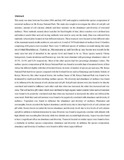| dc.description.abstract | This study was done between November 1996 and July 1997 and sought to establish
the species composition of terrestrial molluscs in Mt. Kenya National Park. The study
also sought to investigate the effect of soil pH, soil moisture, amount of soil calcium,
altitude and litter moisture on the abundance and diversity of terrestrial molluscs.
Three methods; namely direct searches for fixed lengths of time, direct searches over a
defined area and indirect search (litter and soil sieving methods) were used to carry out
the study. Data was collected from randomly selected plots located on four different
transects. These transects were located on four different sides of the mountain namely
north, northwest, east and west.
A total of 7479 individuals of molluscs from 15 families comprising of36 genera were
recorded. There were 72 different species of molluscs recorded during this study out
of which Rhachidina sp., Tayloria sp., Micomaizania sp. and Curvella sp. may
become new records for the study area but only if identified to the species level and
found to be so. Three species namely Vitrina baringoensis, Lauria desiderata and
Punctum sp. were the most abundant with percentage abundance values of 25.7%,
11:5% and 9.2% respectively. Most of the other species had low percentage
abundance values. The mollusc species composition qf Mt. Kenya National Park was
found to resemble that of mountain forests of East Africa but differed slightly with that
of lowland forests. In terms of number of species per unit area, Mt. Kenya National
Park had fewer species compared with the lowland forests such as Kakamega and
Arabuko Sokoke of Kenya. However, like other tropical forests, the mollusc fauna of
Mt. Kenya National Park was found to be dominated by small-sized litter-dwelling
mollusc species.
The diversity and abundance of molluscs was found to be influenced by the amount of
soil calcium and soil pH. Soil pH and calcium were also found to be directly
correlated and tended to influence each other such that when one increased, the other
also increased and vise versa. The soil had low pH values which were attributed to
high organic matter content. Litter and soil moisture were found to be positively
correlated such that when one increased or decreased, the other one followed the same
trend. Both litter and soil moisture were found to be negatively correlated with
abundance and diversity of molluscs.
Vegetation was found to influence the abundance and diversity of molluscs. Plantation
and xeromorphic forests recorded the highest abundance and diversity due to their high
levels of soil calcium and pH while Ocotea forests recorded the lowest abundance and
diversity levels due to low levels of soil calcium and pH in addition to habitat
destruction by man. Diversity was found to negatively correlate with altitude with high
altitude sites recording low diversity while low altitude sites recorded high diversity.
Aspect was also found to have a significant effect on abundance and diversity.
Transects located on similar aspect were found to have a similarity in mollusc species
composition, abundance and diversity. In addition, the species composition,
abundance and diversity of molluscs were found to differ where aspect differed | en_US |

